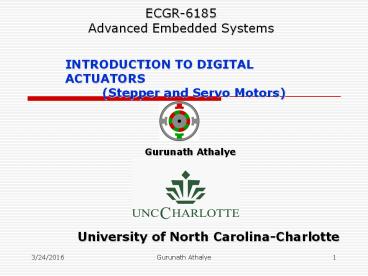ECGR-6185 Advanced Embedded Systems - PowerPoint PPT Presentation
Title:
ECGR-6185 Advanced Embedded Systems
Description:
ECGR-6185 Advanced Embedded Systems INTRODUCTION TO DIGITAL ACTUATORS (Stepper and Servo Motors) Gurunath Athalye University of North Carolina-Charlotte – PowerPoint PPT presentation
Number of Views:105
Avg rating:3.0/5.0
Title: ECGR-6185 Advanced Embedded Systems
1
ECGR-6185Advanced Embedded Systems
INTRODUCTION TO DIGITAL ACTUATORS (Stepper and
Servo Motors)
Gurunath Athalye
University of North Carolina-Charlotte
2
Classification -
- Variable Reluctance
- Permanent Magnet
- Hybrid
- Unifilar
- Bifilar
- Full Step
- Half Step
- Micro Step
Construction
Winding Configurations
Drive Mode
3
Variable Reluctance
- Salient pole stator
- No windings on the rotor
- Stator and rotor pole numbers are different
- Torque is developed by the tendency for the
magnetic circuit to adopt the configuration of
minimum reluctance
4
Permanent Magnet-
- Permanent magnet in the rotor
- Stator is similar to single stack variable
reluctance - High inertia and lower torque to inertia ratio
- Restricted to large step size
5
Hybrid Motor-
- Operated with the combined principles of the PM
and VR motors - Small step angle and a high torque from a small
size
6
Unifilar Motor-
- Only one winding per stator pole
- To change direction requires reversing the
current in the same winding.
7
Bifilar Winding-
- Two identical sets of windings on each stator
pole - Winding configuration simplifies the drive
circuitry
8
Unipolar Motor-
- Current flow is limited in one direction
- To rotate the motor, just apply power to the two
windings in sequence
9
Modes of Stepper Motor
- Full Step
- Half Step
- Micro Step
10
Conceptual Model of Unipolar Stepper Motor Full
Step
- The center taps of the windings are wired to the
positive supply - The two ends of each winding are alternately
grounded to reverse the direction of the field
provided by that winding
11
Full Step Mode-
- Full step sequence showing how binary numbers can
control the motor
12
Conceptual Model of Unipolar Stepper Motor Half
Step
- Same circuitry with different winding sequence
- Two windings are energized at the same instance
13
Half Step Mode-
- Half step sequence showing how binary numbers can
control the motor
14
Micro Stepping Mode-
- Positional resolution is limited because of the
mechanical design of the unit - It allows a stepping motor to stop and hold a
position between the full or half-step positions - The jerky character of low speed stepping motor
operation and the noise at intermediate speeds
15
Principle of Micro Stepping (contd)
- Two sine waves in 'quadrture' (90 degrees out of
phase) form the ideal current drive.
16
Principle of Micro Stepping Phasor
17
Identifying a stepper motor-
Identifying Stepper Motors
18
Identifying a stepper motor-
- Stepper motors have numerous wires, 4, 5, 6, or
8. When you turn the shaft you will usually feel
a "notched" movement. Motors with 4 wires are
probably Bipolar motors and will not work with a
Unipolar control circuit. The most common
configurations are pictured above. You can use
an ohm-meter to find the center tap - the
resistance between the center and a leg is 1/2
that from leg to leg. Measuring from one coil to
the other will show an open circuit, since the 2
coils are not connected. (Notice that if you
touch all the wires together, with power off, the
shaft is difficult to turn!) - Shortcut for finding the proper wiring sequence
- Connect the center tap(s) to the power source
(or current-Limiting resistor.) Connect the
remaining 4 wires in any pattern. If it doesn't
work, you only need try these 2 swaps... - 1 2 4 8 - (arbitrary first
wiring order) 1 2 8 4 - switch end
pair 1 8 2 4 - switch middle pair - You're finished when the motor turns smoothly in
either direction. If the motor turns in the
opposite direction from desired, reverse the
wires so that ABCD would become DCBA.
19
Servo Motors
- Servo motors has an output shaft which can be
positioned to specific angular positions by
sending the servo a coded signal - As long as the coded signal exists on the input
line, the servo will maintain the angular
position of the shaft. - As the coded signal changes, the angular
position of the shaft changes
20
FUNCTIONAL SERVO LOOPS
- Feedback causes the amplitude of the error signal
to decrease, slowing the speed at which the load
is moving - Servo systems are also classified according to
their functions POSITION, VELOCITY, and
ACCELERATION.
21
References-
- Dr. James M. Conrad
- http//www.coe.uncc.edu/jmconrad
- accessed February 2006
- Douglas W. Jones, Control of Stepping Motors A
Tutorial, http//www.cs.uiowa.edu/jones/step/ - accessed February 2006
- http//www.stepperworld.com
- accessed February 2006
- http//hibp.ecse.rpi.edu/connor/education/IEE/IEE
-Lec8.ppt - accessed February 2006
- http//www.tpub.com/content/neets/14187/css/14187_
95.htm - accessed February 2006































